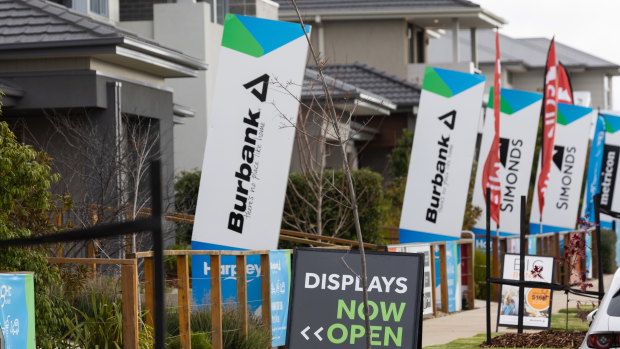This was published 2 years ago
Home buyers start dipping into savings for day-to-day expenses
By Shane Wright and Rachel Clun
Australians are beginning to tap their savings to cover day-to-day expenses as cost-of-living pressures and higher interest rates bite, with warnings one-in-six households could be spending more than they earn by year’s end.
The Reserve Bank, in its six-monthly examination of the strength of the nation’s financial system, said on Thursday that low-income earners were struggling under 10 consecutive rate rises and half were already in mortgage stress.

The Reserve said that at this stage the vast majority of borrowers had continued to service their mortgages, although some were adjusting their spending and saving patterns.Credit: Jason South
The RBA board this week kept the official cash rate at 3.6 per cent amid global financial market instability and to assess the impact of the 3.5 percentage point increase in rates over the past year.
While bank governor Philip Lowe warned on Wednesday that further rate rises were possible in the months ahead, financial markets and an increasing number of market economists believe the next move in rates could be a cut by year’s end or early in 2024.
In its financial stability review, the bank said that at this stage the vast majority of borrowers had continued to service their mortgages, although some were adjusting spending and saving patterns.
There had been a slight rise in the number of people falling behind on loans, but this proportion remained at historically low levels.
However, there had been an increase in people digging into their savings or withdrawing from the pre-payments they had made on their mortgages, which was now above the normal level recorded over recent years.
“A higher share of borrowers are also making relatively small withdrawals compared with previous years, which could suggest that more borrowers are drawing on their buffers to fund regular expenses,” it said.
Higher interest rates and inflation are expected to slow the economy this year and next. Without population growth, the economy would be at risk of falling into a recession.
To test the ability of the economy to withstand further rate rises, the RBA examined the impact on household cash flows under two separate scenarios. The first was based on the bank’s current forecasts, which include unemployment lifting to 3.75 per cent, with a second predicated on the jobless rate jumping to 5.5 per cent by year’s end.
It found if the economy panned out as expected, more than one-in-six households would find themselves in “negative spare cashflow”.
“That is, those whose scheduled mortgage payments and essential living expenses are projected to exceed their household disposable income would reach around 15 per cent by the end of 2023,” the bank said.
Under the same outlook, about 14 per cent of borrowers would deplete all their savings by mid-2024 if they failed to cut their non-essential spending. Even if they did slash their spending on non-essentials by up to 80 per cent, the bank estimates 9 per cent of people would have run out of cash reserves.
If the economy deteriorated more than expected, those in negative cashflow would reach about 17 per cent, with first-time buyers and those who lost either their job or some working hours most at risk of being in financial trouble.
Some people are already hurting, with the bank revealing 45 per cent of the bottom quarter of earners were already paying at least a third of their income towards servicing their mortgage. A year ago, the proportion was around 25 per cent.
“Those borrowers with low mortgage prepayments who are also highly indebted are more likely to experience debt-servicing challenges. This risk is highest for those who also have low incomes. This is because low-income households typically have less ability to draw on wealth or cut back on discretionary consumption to free up cashflow for debt servicing,” the bank said.
Among the nation’s top quarter of income earners, the proportion spending a third of their income on their mortgage was just 5 per cent.
AMP Capital deputy chief economist Diana Mousina said the RBA’s outlook for the economy would be challenged in coming months, arguing the situation domestically was deteriorating rather than stabilising.
The banking issues afflicting the United States and Europe would also filter through to the Australian financial system.
“Further financial contagion from the banking sector issues also can’t be ruled out, which would also justify keeping interest rates steady. By the end of the year, we expect the RBA to start cutting the cash rate,” she said.
Cut through the noise of federal politics with news, views and expert analysis from Jacqueline Maley. Subscribers can sign up to our weekly Inside Politics newsletter here.